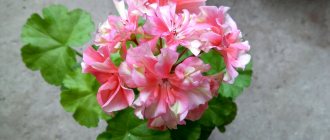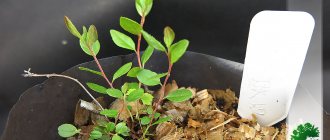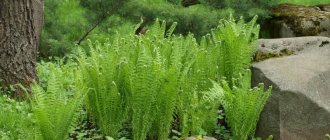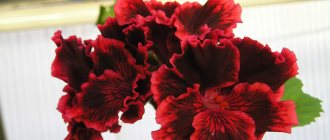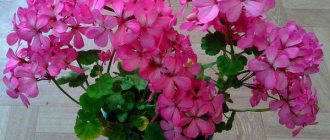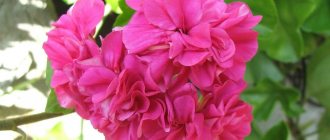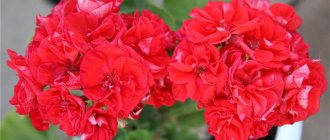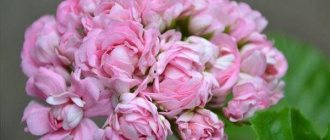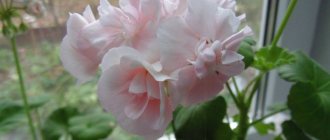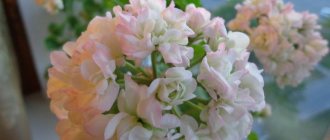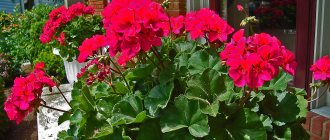Pink Rambler: main features of the variety
The buds of Pink Rambler bloom gradually; after full opening, they retain the correct shape of miniature garden roses.
The inflorescences look impressive due to the combination of a thick pink shade on the inside of the petal and an almost white underside.
The size of the buds is quite large - 4-5 cm in diameter, the caps are formed dense and retain freshness for a long time, without falling off.
Pelargonium Pink Rambler grows a powerful, well-leafed bush with virtually no formation.
To obtain a lush crown, periodic pinching and spring pruning as needed is sufficient. The variety does not expose the trunk and remains decorative in adulthood.
The contrast zone on the leaves appears in sunny conditions - in such conditions Pink Rambler will show itself in all its beauty.
The green mass of pelargonium is rich green and against its background the blossoming inflorescences immediately catch the eye.
Good feeding for this variety is extremely important, since if all the necessary components are received, Pink Rambler lays a large number of flower buds.
In addition, the hats turn out to be lush and stuffed, rose to rose.
Pink Rambler does not show its potential immediately, which is typical for rosebud varieties. It blooms later than other zonal pelargoniums, but the delay is fully compensated by the beauty of the buds.
The plant must be propagated vegetatively - this guarantees the transmission of all varietal characteristics.
Cuttings easily take root in loose substrate; if desired, they can be pinched so that the crown begins to branch at a young age.
Growing rules
Pink Rambler needs conditions typical for zonal pelargoniums, that is, good lighting and warm content, a nutritious, but at the same time loose, permeable substrate.
Thus, growing Pink Rambler pelargonium comes down to several points:
- Lighting. It is preferable to have well-lit window sills that are exposed to the sun for several hours a day. It is advisable to shade the pots on the south side so that the leaves do not suffer from burns; it is better not to grow them on northern windows.
- Watering. It is necessary to moisten the soil constantly, as the top layer of the substrate dries, but always in moderation. The earthen lump should neither dry out nor become waterlogged.
- Trimming. To obtain a compact bush with a harmonious crown, pelargonium must be pruned. Strong shortening of shoots is carried out at the end of February, sanitary pruning is carried out as necessary. Pinching the apical and lateral cuttings is also required.
- Feeding. During the period of bud formation and flowering, Pink Rambler must be fed using fertilizers for geraniums or compositions for flowering indoor plants.
Like other zonal pelargoniums, Pink Rambler loves fresh air and ventilation, but reacts negatively to drafts.
For this reason, with the onset of warm weather, the bush is taken out to the balcony, veranda or loggia, creating flower arrangements and always returning it to the apartment before the cold weather.
The optimal temperature for growing and flowering Pink Rambler geranium is between +17-+23 degrees.
When the temperature drops below +12, the plant stops developing and often dies from hypothermia of the root system.
The Pink Rambler variety will decorate your windowsill, delighting you with lush flowering if grown correctly.
Where and how to plant it?
Red Pandora does not require specific or complex care . Even a novice amateur gardener can cope with this. Ceramic pots with a hole in the bottom are most suitable for planting and further cultivation. They conduct heat worse, so a constant temperature of the earth is maintained, and the hole removes excess moisture, which prevents the roots of the plant from rotting. Immediately after planting, geraniums must be in a shaded place for two weeks.
Lighting and location
For planting, choose a place with diffused sunlight. A window sill facing east is ideal. If the light is too bright, then it is necessary to shade the geranium, because it does not like direct rays. It is also important that there are no drafts or sudden temperature changes in the room where the pelargonium is located. So, a windowsill with a battery under it is not suitable for growing this plant .
You should also avoid airing during the cold season to prevent the occurrence of diseases in the plant. Red Pandora pelargonium feels most comfortable on a glassed-in terrace with a moderate amount of light and plenty of air.
Important . Rain and wind are detrimental to this variety. Therefore, when cold weather sets in, geranium is immediately brought into the warmth, as it does not tolerate drafts well.
Soil requirements
Turf soil with a high organic content is optimal for pelargonium . It is laid on top of drainage, which is suitable for expanded clay. Nitrogen fertilizers will not be superfluous when planting; one spoon is enough. They will provide the necessary nutrition to the young plant.
Stories of the creation of the Pink Rambler variety
Pelargonium Pink Rambler is a member of the Pelargonium x hortorum family. This plant was first bred in France in the 19th century. It appeared in Russia at the same time. This variety was bred through random crossing, as a result of which a mutation occurred. Flower growers in England immediately fell in love with the new variety and began making unusual bouquets and boutonnieres from the buds.
Note! In addition to Pink Rambler, the Rambler series includes several more varieties: pelargonium Red Rambler, Plum Rambler and Scarlet Rambler. They are all similar in appearance, differing only in color.
Botanical description and history
The first variety of tulip-shaped pelargonium was obtained in 1966 by specialists from the American nursery “Andrea”. In Europe, they learned about the plant only after 2 decades, and among flower growers there was a lot of controversy about its origin - due to the structure of the flower and the low availability of its stamens and pistil, this variety is difficult to breed and there is a theory that it arose as a result of natural mutations of some varieties of zonal pelargonium.
All varieties of tulip-shaped pelargonium have different growth rates, shoot heights, colors, shapes and even the number of petals.
Features of the variety
Pelargonium Pink Rambler is a currently famous geranium variety. The buds of the plant have a rare two-color color, and their appearance resembles rose inflorescences. The height of the bush reaches 50-60 cm.
Pelargonium Pink Rambler
For comparison! The pelargonium variety Red Rambler has bright red flowers, while Plum Rambler has a mixture of shades of plum and burgundy.
Pelargonium leaves have a specific smell, and essential oil (geranium) is extracted from them.
You can grow this variety of geranium both at home and in the garden. In the latter case, it produces buds before the cool autumn evenings. Pelargonium can withstand temperatures not lower than +12 degrees. Therefore, you need to monitor the temperature.
Flowering period
The inflorescences of geraniums, which have a multi-colored color, appear a little later than in other species. The flowering period depends on proper care, watering and fertilization. Most often, the plant blooms from spring to early autumn. During the season, one bush can produce more than 20 beautiful flowers. The inside of the buds is pink or red. The outer part of the petals is painted white.
One bush can produce more than 20 beautiful flowers per season
Pollination
Pelargonium Pink Rambler is pollinated both independently and with the help of insects. To quickly obtain seeds, artificial pollination can be carried out. Process description:
- choose male and female from the blooming buds;
- collect pollen from the father's flower;
- remove the mother stamens, you can use tweezers for this;
- let the plant stand overnight in this form;
- the next day, take a fluffy brush and apply pollen to the pistils that hatched overnight.
Buy pelargonium tulip seeds in the online store
Many flower lovers want to have an exotic beauty on their windowsill or in their greenhouse.
Varieties of pelargonium photos and names
Before you buy tulip pelargonium seeds in an online store, decide on the plant variety. The principle of caring for flowers of this variety is the same, the appearance of pelargonium and the shade of flowers are different.
Pelargonium variety Patricia Andrea
A variety of pelargonium obtained in a Boston nursery by crossing two different plant species. The shrub is small in size; pelargonium blooms with miniature flowers, collected in inflorescences and reminiscent of a bouquet of tulips.
The color of the flowers is usually pink or burgundy. With proper care, geranium blooms all year round.
Pelargonium variety Lilian Andrea
The Lilian variety belongs to the dwarf pelargonium; another name for the flower is miniature geranium. The shrub is small, and with adequate care it blooms almost all year round.
The inflorescences are bright, predominantly scarlet, dark red. Caring for the plant does not differ from the system for growing similar varieties of tulip-shaped pelargonium.
Pelargonium variety Red Pandora
Rosebud pelargonium blooms with red flowers reminiscent of tulip buds. The plant has large leaves that are velvety to the touch. It is grown indoors, the size of the bush is medium.
Many collectors pay attention to this variety. The flower is quite unusual; with regular care, it blooms all year round without rest. Flowers do not drop, leaves do not curl in autumn
The variety is suitable for home gardens, greenhouses, and for growing for sale.
It does not drop flowers, the leaves do not curl in autumn. The variety is suitable for home gardens, greenhouses, and for growing for sale.
Pelargonium variety Pink Pandora
The bush is medium in size and blooms with semi-double pink flowers. The flowers are small, collected in inflorescences, reminiscent of a bouquet of tulips. The plant looks impressive on a windowsill or in a greenhouse.
Pelargonium variety Marbacka Tulpan
The shrub blooms with delicate, white flowers. Small flowers are collected in inflorescences, each segment resembles a tulip bud. Caring for the plant is no different from the maintenance system for other types of geraniums.
Which variety of tulip geranium to choose depends on your preferences.
Tulip pelargonium how to care
Tulip pelargonium has its own characteristics. Violation of the care system will lead to the fact that the flower petals will fully open and the plant will turn into an ordinary geranium.
To preserve the appearance of the shrub, follow several recommendations:
- the shoots of the plant are pinched so that the bush has splendor and does not stretch upward;
- Pelargonium should be placed in a place where there are no drafts. If you take a flower outside in the summer, make sure that there is no wind in this place;
- flowers that have fully opened are removed from the bushes;
- Make sure that no wilted, dry flowers or leaves remain on the inflorescences.
Where to buy Pelargonium seeds
Buying tulip pelargonium seeds in an online store is easier than searching for them in regular flower shops. This exotic type of flower is not so popular in the country, so it is rare.
Our online store offers interesting varieties of pelargonium, high-quality seeds, and favorable purchasing conditions. Select plants taking into account the amount of free time, plans for the winter garden, and your preferences. You can make a request to purchase Pelargonium seeds through the feedback service.
Tulip pelargonium will complement the existing flowers well. Does not conflict with neighbors, does not require expensive fertilizing, and is practically not affected by pests. You get a beautiful, unpretentious plant at competitive prices.
Features of cultivation
When growing, it is necessary to follow agrotechnical rules. These include: proper planting, subsequent care and reproduction.
Landing rules
In order for the plant to quickly take root, it is best to purchase a ready-grown seedling. It should not be planted in too light soil. Geranium loves loose soil that is not too rich in nutrients. Plant sparsely, per 1 sq. m, 10 small seedlings are enough.
It is best to plant it in early June
To prevent the plant from freezing, it is best to plant it in early June.
Pelargonium variety Pink Rambler loves sunlight, so it should not be planted near tall plants. For the first 7 days, the seedling needs to be watered abundantly so that the roots begin to actively grow.
Important! There is no need to introduce fertilizing so as not to burn the still thin rhizome.
Rules of care
After rooting, pelargonium is watered no more than three times a week. Watering too frequently can harm the plant. Those inflorescences that have already bloomed are cut off so that the plant can direct all its energy to new buds. The plant needs to be fed only on warm days, when the mark on the thermometer does not fall below +14 degrees. In winter, geraniums are allowed to rest: watering is reduced and they are put in a dark place without applying fertilizers.
Advantages and disadvantages of the variety
Pelargonium Pink Rambler has both disadvantages and advantages, which were highlighted by flower growers.
- elegant appearance;
- unpretentious in care;
- pollinated in several ways;
- easy reproduction;
- varied use of flowers.
- the smell from the leaves, which not everyone likes;
- low frost resistance.
This plant does not have many disadvantages, so even inexperienced gardeners begin to grow it. With proper care, pelargonium of this variety will delight the owner with its beautiful flowering.
Reproduction
The preferred method of propagation is propagation using cuttings.
In the spring or at the end of August, immediately after flowering, the apical shoots are cut off and either placed in water or in a mixture of sand and peat. After the cuttings have given roots, they are transplanted into fertile soil the same as for an adult plant.
It is more difficult to grow geranium from seeds. There is a danger that the resulting plant will not have its own unique characteristics; moreover, it is quite difficult to buy high-quality seeds of this geranium. However, if you decide to grow geranium from seeds, you should adhere to the following algorithm.
- Before planting, lightly rub the seeds with sandpaper or run a knife over them for better germination.
- Soak the seeds in a growth stimulator, then in a solution of potassium permanganate and finally in plain water for three hours.
- The soil for planting seeds should consist of turf (two parts), peat (two parts) and sand (one part).
- Seeds should be planted at a distance of five centimeters from each other; the seeds should not be deepened too much.
- The container in which the seeds are planted should be wrapped in cling film to create a greenhouse effect until the seedlings, which appear in about two weeks; care must be taken to ensure that the soil does not dry out.
- When two leaves appear on the geranium seedlings, the plant can be transplanted into a pot.
The abundance of species and varieties of such a familiar, but very beautiful flower - geranium is varied and surprising. On our website you can learn about some of them: about the perennial Peony and the annual Robert, about Rosanna that blooms all summer and the mysterious Plenum geranium, read how to grow white and black geraniums, why Max Fry is so good, how to care for the fragrant Lemon and fragrant.
Despite some peculiarities in care, tulip-shaped geranium is rightfully gaining more and more fans among flower growers. The unobtrusive delicate beauty of this variety provides it with a worthy place among ornamental plants in apartments, houses, balconies and garden plots.
Features of rosebud pelargoniums
Rosebud pelargonium, known to many, is included in the group of zonal plants. Today, many varieties of this amazing flower have been bred, but they are all united by one key characteristic: the petals of the plant are double, and there are so many of them that they do not even open completely, thereby even more reminiscent of the queen of flowers - the rose. This variety has a striking resemblance to the roses loved by many.
What’s interesting is that sometimes you can tell just by the shape of the leaves what exactly you’re dealing with, so pink-shaped pelargonium looks like the queen of flowers in the garden. A characteristic feature of the plant is the fact that the inflorescences are odorless. The shrub itself is inconspicuous in appearance; its main decoration is considered to be its stunningly beautiful small buds. Such a hybrid has been known since the 18th century. True, the plant was bred due to a random mutation.
Only years later did breeders give this variety a complete aesthetic appearance. Caring for such pseudo-roses is not particularly difficult. Study the basic recommendations of experts, and you can safely plant a plant on your site. Remember: if you prefer garden varieties of rosebud pelargonium, the varieties will need to be updated every 4-5 years, since over time they may lose their lushness and flowering intensity.
Rules of care
Pelargonium blooms amazingly beautifully. But in order for this plant to delight you with the variety of blossoming buds, you need to competently approach the implementation of the most important agricultural techniques. Home care primarily includes moderate watering and protection from direct sunlight.
Neglect such recommendations, and the leaf blade will fade, the shrub itself will not look very lush and aesthetically pleasing, and the intensity of flowering will noticeably decrease. It is very important to properly moisten the plant substrate. If we are talking about home pelargonium, it is necessary not to overdo it with soil irrigation. Be sure to check the soil moisture level. Test the soil with your finger - if there is still soil on it, you can wait a little with watering. Otherwise, proceed to moisten the substrate.
Pelargonium can bloom not only on your windowsill, but also on the balcony or in the garden.
However, take into account the fact that prolonged severe frosts are not the best conditions for wintering a plant. It is advisable that temperatures do not fall below +10 °C. In this case, pelargonium will wait until next spring without any problems.
Planting in open ground
Tulip geranium, as it is sometimes mistakenly called, is not cultivated in open ground under the agroclimatic conditions of a temperate continental climate. In order for the plant to delight the eye with its luxurious flowering, it must be grown in a pot, which in warm weather can be moved to fresh air (balcony, terrace). The main thing is not to leave the flower in the wind.
The optimal temperature depends on the time of year. In summer, pelargonium develops well at 21-26 °C, and in winter it requires maintaining temperature values within 14-16 °C.
Pelargonium needs fertile and loose soil. The latter quality contributes to better aeration performance and the ability to pass water. And it is also necessary to place a drainage layer at the bottom of the pot to prevent moisture stagnation in the roots. A mixture of peat, garden soil and sand in a ratio of 2:2:1 is used as a suitable substrate.
The ornamental plant does not like bright light, so you should not place the pot on southern window sills, where the leaves may be damaged by the burning rays of the sun. To prevent the shoots from stretching out, additional lighting from fluorescent lamps should be provided in winter.
The best varieties
There are very, very many flowering varieties of pelargonium bred by breeders. Among the most popular are pelargonium varieties Rosebud supreme, Red scarlet, Snow and Arctic. Consider the key characteristics of the most popular varieties of rosacea geraniums in order to have only exceptional varieties in your garden:
- Pelargonium Vectis rosebud. A mature shrub that looks miniature, but looks very attractive. In addition, such a plant is not difficult to form. Among the main advantages of the variety is lush and long-lasting flowering. The roses have a bright red hue. Interestingly, the petals on the outside are slightly lighter than on the inside. Having planted such a shrub in your garden plot, you will admire its flowering for a long time;
- Pink rambler. Just like pelargonium, the Red Rambler variety is considered one of the most famous flower varieties. This shrub is very bright and lush, its leaves have a corrugated shape, and the flowers are bright pink with a hint of red. The true charm of this specimen is given by the exceptional shape of the petals, as well as the presence of a lighter shade on their front side;
- Pelargonium Bornholm. On such a shrub, the flowers open rather slowly. They have a rich red hue, and the texture is very satin-like in appearance. Be patient until this geranium blooms completely. But in the future she will not shed her beautiful buds for a long time. However, flowers are not the only advantage of the variety. Flower growers often pay attention to the amazing mesh pattern on the leaves of the plant;
- pelargonium variety Vit rosen. The flowers of this specimen are rich white in color, but at the base the petals have a greenish tint. They are double, so they form very lush inflorescences;
- pelargonium variety Arctic snow. It is not difficult to guess what color the petals of this relatively young variety are. However, a characteristic feature of the plant in the “snow” shade is the star-shaped shape of the petals, which can be covered with stripes;
- Pelargonium domestica Black pearl. This zonal plant forms voluminous, lush inflorescences of raspberry-red color. When the buds just open, they have a predominant burgundy color. Such a flower is considered finicky to care for (for example, the shape of a bush is difficult to shape), but it blooms incomparably.
Whatever variety of pelargonium you prefer - Red Scarlet, Arctic Snow or Red Rambler - this flower will become an original decoration for your blooming corner, because its beauty is in no way inferior to even a rose.
Common diseases and pests
The Red Pandora variety itself is quite unpretentious and disease resistant . However, there are still cases when pelargonium gets sick. For proper treatment, first of all, it is necessary to identify the pathogen. Most often, geraniums are affected by such pests as gray rot (gray spots, as if powder had been poured onto the leaves), whitefly, mealybugs, spider mites (a dense thin web appears between the leaves) and rust (appears as white circles and affects mainly the leaves).
All of them are the result of improper care. Often the stems and leaves of the plant begin to turn red, which is mistakenly taken for a disease. In fact, this is not entirely true. A reddish tint appears when geraniums freeze . This signals that she needs more warmth. Even if there is only a suspicion of a plant disease, do not delay treatment.
Infection occurs very quickly, and now, instead of just one, all your geraniums are sick. To treat rot and rust, the affected leaves are removed and the plant is treated with antifungal drugs. To combat ticks, use a special product that is sold in flower shops.
